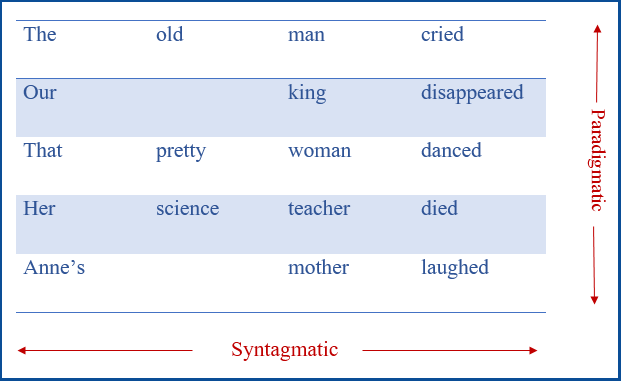Key Difference – Paradigm vs Syntagm
Paradigm and syntagm are two concepts in semiotics that guide how signs relate to one another. Both these concepts are employed in textual analysis to facilitate effective communication using signs. The primary distinction between paradigm and syntagm is that paradigms concern substitution, while syntagms involve positioning. The terms syntagmatic relationship and paradigmatic relationship also originate from syntagm and paradigm and pertain to the relationship with other syntagms and paradigms, respectively.
What is a Paradigm?
A paradigm is a set of linguistic items that create mutually exclusive choices in specific syntactic roles. A paradigmatic relationship includes signs that can replace one another. This replacement typically changes the meaning. In paradigmatic relationships, a lexical item can generally be substituted by another of the same category. For example, a noun is replaced by a noun and a verb by a verb. If we consider the example sentences used for syntagms, such as “Anne killed a mosquito,” the word “mosquito” can be replaced by various words that would imply similar meanings. Anne might have killed a spider, bug, ant, or another insect. Each of these words belongs to a paradigm of animals or insects Anne might have killed.
What is a Syntagm?
A syntagm is a linguistic unit consisting of a set of linguist forms, such as letters, phonemes, or words, that are in a sequential relationship to one another. A syntagm is also known as a chain of signifiers. The relationship within a syntagm is called a syntagmatic relationship. Syntagmatic relationships involve a sequence of signs that create meaning as a whole. They are all about positioning. Words that make up sentences, sentences that make up paragraphs, and paragraphs that make up chapters are some examples of syntagms and syntagmatic relationships. To be more precise, words in a sentence can be considered as syntagms, and they form a syntagmatic relationship that gives rise to meaning. Changing the sequence of syntagms in the sentence can result in a change of meaning. For example, “Anne killed a mosquito” and “A mosquito killed Anne” use the same words (syntagms), but the difference in the order (syntagmatic relationship) results in two very different meanings.
What is the difference between Paradigm and Syntagm?
Paradigm and syntagm have distinct meanings. A paradigm is a set of linguistic items that form mutually exclusive choices in particular syntactic roles, while a syntagm is a linguistic unit consisting of a set of linguistic forms (phonemes, words, or phrases) that are in a sequential relationship to one another. In paradigmatic relationships, signs get meaning from their association with other signs. In syntagmatic relationships, signs get meaning from their sequential order. Paradigmatic relationships focus on substitution, while syntagmatic relationships concentrate on positioning.
Summary – Paradigm vs Syntagm
Paradigms and syntagms guide the relationship between signs. Both paradigmatic and syntagmatic relationships play a significant role in determining the meaning of a linguistic unit. In paradigmatic relationships, the signs get their meaning with their association of other signs, whereas in syntagmatic relationships, signs get their meaning from their sequence.
Key Takeaways
- The main difference between paradigm and syntagm is that paradigms concern substitution, while syntagms involve positioning.
- Paradigmatic relationships include signs that can replace one another, while syntagmatic relationships involve a sequence of signs that create meaning as a whole.
- Both paradigmatic and syntagmatic relationships play a significant role in determining the meaning of a linguistic unit.
